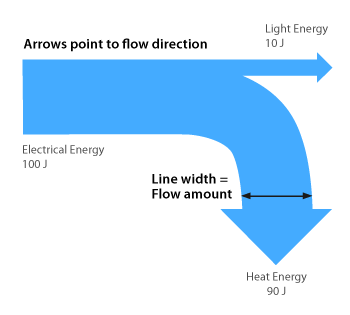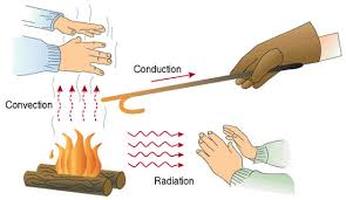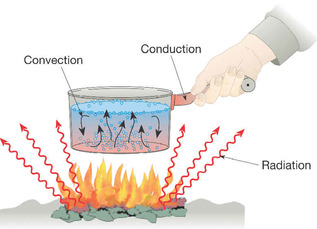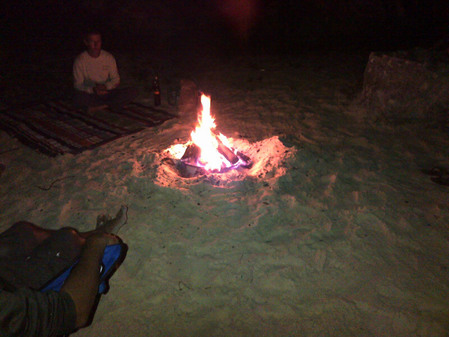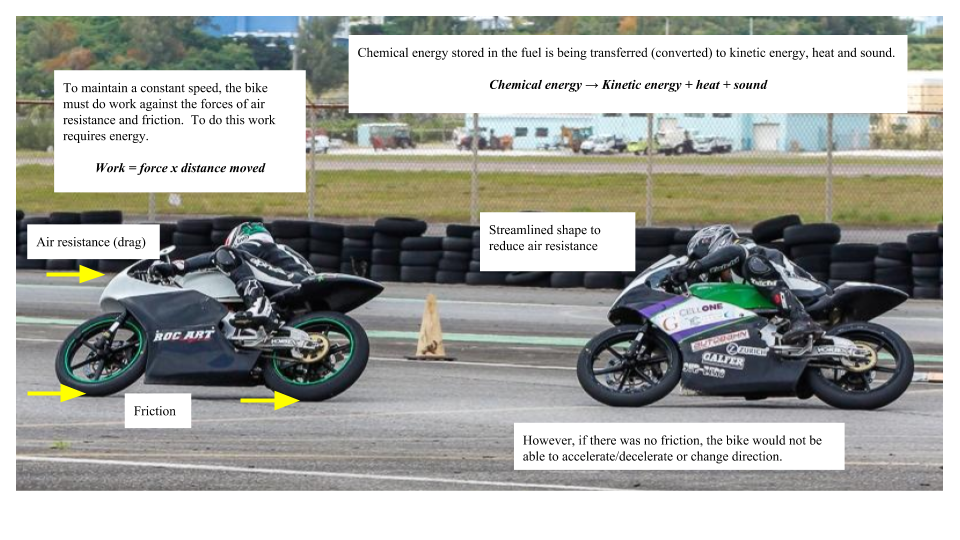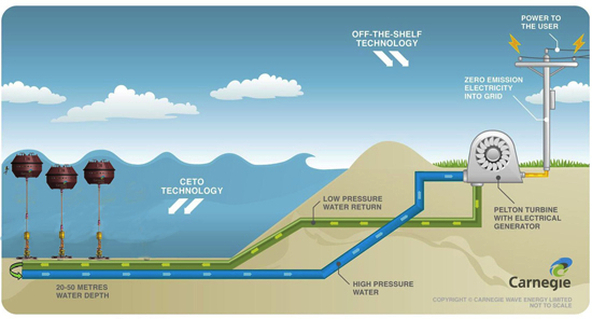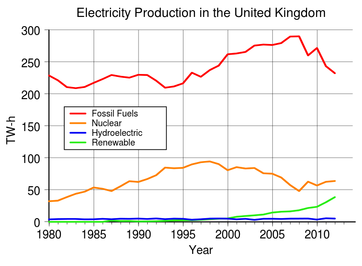Energy is a fundamental concept in physics. It is the ability to do work, which in physical terms is the product of a force applied over a distance. It comes in many forms and can be transformed ("transferred") from one form to another. It is this transfer that makes things happen.
We look at the three methods by which heat energy is transferred; conduction, convection and radiation. Finally, and most importantly, we investigate how electrical energy is generated, the nature of fossil fuels and effects of burning them, and different methods of utilizing renewable energy resources.
This unit has a lot a variety within it. The concepts of energy transfer and efficiency tends to be rather straightforward, then we move on to heat transfer, which students often struggle with. The next topics involve the mathematical treatment of energy with concepts such as work, power, gravitational potential energy and kinetic energy. We finish the topic by looking at the energy resources that are used to generate electricity, with a strong emphasis on renewables.
We look at the three methods by which heat energy is transferred; conduction, convection and radiation. Finally, and most importantly, we investigate how electrical energy is generated, the nature of fossil fuels and effects of burning them, and different methods of utilizing renewable energy resources.
This unit has a lot a variety within it. The concepts of energy transfer and efficiency tends to be rather straightforward, then we move on to heat transfer, which students often struggle with. The next topics involve the mathematical treatment of energy with concepts such as work, power, gravitational potential energy and kinetic energy. We finish the topic by looking at the energy resources that are used to generate electricity, with a strong emphasis on renewables.
Student booklet - October 2022
2.1 - Energy Transfer
- Describe energy transfers involving the following forms of energy: thermal (heat), light, electrical, sound, kinetic, chemical, nuclear and potential (elastic and gravitational),
- Understand that energy is conserved and know and use the relationship: efficiency = useful energy output / total energy output.
- Draw energy flow (sankey) diagrams for a variety of everyday and scientific situations.
Energy exists in many forms, but we can reduce it down to 10 basic ones. These can be classed as 'active' as they are moving or 'stored' if they are standing by ready to do something. The stored energy is referred to as 'potential energy' as it has the potential to do something!
ACTIVE |
STORED |
Kinetic |
Gravitational Potential |
Electrical |
Elastic Potential |
Sound |
Chemical Potential |
Magnetic |
Nuclear Potential |
Light |
|
Heat |
Science is all about change. Change happens when energy is transferred from one form to another. This is known as an energy transfer. We write them in a similar manner to how we write food chains and chemical reactions. For example, the energy transfer for a light bulb is:
\[\text{electrical} \rightarrow \text{light} + \text{heat}\]
and that of the process of photosynthesis in a leaf is:
\[\text{light} \rightarrow \text{chemical potential} + \text{heat}\]
Energy transfers never just go to one useful form. Some energy is always lost to the system, usually as heat. The system gets hotter and radiates energy outwards, which ultimately heats up the atmosphere and is then radiated out to space. Energy can never be destroyed, but it can be lost to us. The more steps there are in an energy transfer, the more energy is lost. This reduces the efficiency. For example, consider a light bulb in your house: BELCO burns the fuel to generate electricity. The engines get hot and not all of the energy is transferred to electrical energy (only about 40%). Then the transformers and wires get warm, further losing heat energy. The light bulb itself is only about 5% efficient as most of the energy is lost to heat. Ultimately, the efficiency of the transfer of chemical energy to light energy is less than 5% of 40% - somewhere around 2%. If that! Once you consider that the chemical energy originally came from photosynthesis millions of years ago, the efficiency of the complete transfer from sunlight to light is ridiculously tiny...
\[\text{electrical} \rightarrow \text{light} + \text{heat}\]
and that of the process of photosynthesis in a leaf is:
\[\text{light} \rightarrow \text{chemical potential} + \text{heat}\]
Energy transfers never just go to one useful form. Some energy is always lost to the system, usually as heat. The system gets hotter and radiates energy outwards, which ultimately heats up the atmosphere and is then radiated out to space. Energy can never be destroyed, but it can be lost to us. The more steps there are in an energy transfer, the more energy is lost. This reduces the efficiency. For example, consider a light bulb in your house: BELCO burns the fuel to generate electricity. The engines get hot and not all of the energy is transferred to electrical energy (only about 40%). Then the transformers and wires get warm, further losing heat energy. The light bulb itself is only about 5% efficient as most of the energy is lost to heat. Ultimately, the efficiency of the transfer of chemical energy to light energy is less than 5% of 40% - somewhere around 2%. If that! Once you consider that the chemical energy originally came from photosynthesis millions of years ago, the efficiency of the complete transfer from sunlight to light is ridiculously tiny...
|
Sankey Diagram
Sankey invented these diagrams to show how resources are managed through a supply chain. They are great to show the transfer of energy from one form to many others. The straight arrows lead to useful output energy, while the arrows that peel off vertically show energy that is lost during the process. The relative sizes of the arrows show the amount usefully transferred or lost (usually as heat). \[\text{efficiency} = \frac{\text{useful energy output}}{\text{total energy input}} \times 100%\] \[\text{efficiency} = \frac{10 \text{ J}}{100\text{ J}} \times 100% = 10% \] |
2.2 - Heat Transfer
- Describe how energy transfer may take place by conduction, convection and radiation.
- Explain the role of convection in everyday phenomena.
- Explain how insulation is used to reduce energy transfers from buildings and the human body.
There are three heat transfer mechanisms: conduction, convection and radiation.
- Conduction is the passing of molecular vibrational energy from one molecule to another. Metals are by far the best thermal conductors, which is why saucepans generally have wooden or plastic handles.
- Convection occurs within fluids (liquids and gases). The higher the temperature of a fluid, the more spread out the particles become, which leads to a drop in the density. The less dense fluid then rises above the cooler, more dense fluid. Common mistake: 'heat rises' - should be 'warm fluids rises'. This is the process that drives the weather and ocean systems of the world!
- Radiation is the electromagnetic radiation that is emitted from any object above absolute zero. As far as we are concerned this is usually infra-red (IR) radiation. The surface of the Sun and the filaments of lightbulbs are hot enough to emit visible light. IR radiation travels at the speed of light and is the only one heat transfer mechanism that can travel through a vacuum. Dull, black objects are the best absorbers and emitters of thermal radiation, which is why black clothing and cars get so hot during a Bermudian summer.
|
Island-life.... a beach bonfire is a fantastic way to spend an evening. During the evening, especially when the skies are clear and the stars are out, the sand cools dramatically from warm to cold due to emission of heat radiation to the atmosphere. By 11 pm, the sand is decidedly chilly, but the ocean is still pleasantly warm. The water has a much higher specific heat capacity than sand. Last year a couple of students camped out and measured the hourly variation in temperature of the sand and sea!
(Elbow Beach Oct 2015) Question: why do the flames go upwards? |
|
A convective Morgan's Cloud forming over Bermuda on a hot summer afternoon. As the island heats up more than the ocean, moisture in the ground evaporates and joins the rising warmer air as the convection starts. As the warm, moist air rises it cools and the water vapour condenses to form water droplets (clouds). Convective clouds like this are typically cumulus (fluffy) in nature. Depending on the moisture content and the difference in temperature they can even form thunderclouds! It appears to be raining in Somerset when I took this photo.
For a sailor, the formation of a overland convective cloud, such as this, is a sure sign that a sea breeze will form on an otherwise calm day. The conditions required are: no gradient wind (synoptic), temperature difference of at least 5 degrees between the ocean and the island. |
Spacey Stuff - Science and the Apollo Missions. The astronauts managed to set up probes to measure the surface temperature, but in doing so they disturbed the surface, which changed the absorption characteristics from heat radiation. Fascinating bit of history and how easy it is to foul up an experiment!
2.3 - Quantitative Calculations on Work, Energy and Power
- Understand that ‘work done’ is equal to energy transferred and to able to calculate it.
- Know that kinetic energy is a measure of the amount of energy of a moving object and be able to calculate it.
- Understand that Gravitational potential energy is the amount of energy of an object due to its height above the ground.
- Describe power as the rate of transfer of energy or the rate of doing work
- understand how conservation of energy produces a link between gravitational potential energy, kinetic energy and work
Work
The quantification of work and energy started during the industrial revolution when machines started replacing horses. In order to figure out the size of the machine and how much fuel it would require it was needed to come up with values for the amount of work that it needed to do. The name stuck, so the quantification of effort is known as 'work'. Mechanical work is a measure of how much force is required to do a job over the distance that it needs to be moved. Usually shortened to just 'work'. Strictly speaking, the definition of energy is the ability to do work. If you have \(400\text{ J}\) of energy, the maximum amount of work that you can achieve would be \(400 \text{ J}\). (actually.. this is impossible as no energy transfer can ever be \(100%\) efficient.)
\[W=F\Delta x\]
For example: If a box needs a force of \(2.0 \text{ N}\) to move it and it is moved over a distance of \(8.0\text{ m}\), then we will have done \(2.0 \times 8.0 = 8\text{ Nm}\) of work. Work has been given a special unit called the joule \( (\text{J})\) in honour of James Prescott Joule who realised that heat energy could be exchanged both ways for mechanical energy.
The tricky thing is what happens if you apply a force, i.e. putting in effort, but not moving it! You are not actually achieving anything, so the work done is zero. Even though it feels like you are doing work! An example would be holding a physics book still above your head. Your muscles will ache over time, but you are not doing any work. This seems counterintuitive.
The old unit for work was the calorie, which is still in use for food and exercise in the US. For example, I did 500 kilocalories of work on the rowing machine at the gym this morning. Kilocalories in the US are denoted by a capital C. No idea why....
\[1 \text{ calorie} = 4.2\text{ J}\]
\[1\text{ kilocalorie} = 1\text{ Calorie} = 4200\text{ J}\]
The quantification of work and energy started during the industrial revolution when machines started replacing horses. In order to figure out the size of the machine and how much fuel it would require it was needed to come up with values for the amount of work that it needed to do. The name stuck, so the quantification of effort is known as 'work'. Mechanical work is a measure of how much force is required to do a job over the distance that it needs to be moved. Usually shortened to just 'work'. Strictly speaking, the definition of energy is the ability to do work. If you have \(400\text{ J}\) of energy, the maximum amount of work that you can achieve would be \(400 \text{ J}\). (actually.. this is impossible as no energy transfer can ever be \(100%\) efficient.)
\[W=F\Delta x\]
For example: If a box needs a force of \(2.0 \text{ N}\) to move it and it is moved over a distance of \(8.0\text{ m}\), then we will have done \(2.0 \times 8.0 = 8\text{ Nm}\) of work. Work has been given a special unit called the joule \( (\text{J})\) in honour of James Prescott Joule who realised that heat energy could be exchanged both ways for mechanical energy.
The tricky thing is what happens if you apply a force, i.e. putting in effort, but not moving it! You are not actually achieving anything, so the work done is zero. Even though it feels like you are doing work! An example would be holding a physics book still above your head. Your muscles will ache over time, but you are not doing any work. This seems counterintuitive.
The old unit for work was the calorie, which is still in use for food and exercise in the US. For example, I did 500 kilocalories of work on the rowing machine at the gym this morning. Kilocalories in the US are denoted by a capital C. No idea why....
\[1 \text{ calorie} = 4.2\text{ J}\]
\[1\text{ kilocalorie} = 1\text{ Calorie} = 4200\text{ J}\]
Power
Power is a measure of the rate of doing work. A machine that can achieve the same task faster is more powerful than one that does it slowly. The units are joules/second, and have been given the special name of watts, \((\text{W})\) in honour of James Watt who invented the world's first useful steam engine. The unit created by Watt back when he was first marketing his engines was the 'horsepower', which today is only really still used by outboard engines on boats. Probably as the number sounds better.
\[P = \frac{W}{t}\]
The power rating is often seen on electrical devices and tells you the rate of using electrical energy. A \(100\text{ W}\) light bulb is brighter and uses more electricity per second than a \(40\text{ W}\) bulb.
Power is a measure of the rate of doing work. A machine that can achieve the same task faster is more powerful than one that does it slowly. The units are joules/second, and have been given the special name of watts, \((\text{W})\) in honour of James Watt who invented the world's first useful steam engine. The unit created by Watt back when he was first marketing his engines was the 'horsepower', which today is only really still used by outboard engines on boats. Probably as the number sounds better.
\[P = \frac{W}{t}\]
The power rating is often seen on electrical devices and tells you the rate of using electrical energy. A \(100\text{ W}\) light bulb is brighter and uses more electricity per second than a \(40\text{ W}\) bulb.
|
Gravitational Potential Energy
Gravitational Potential Energy, \(GPE\), is a measure of the work that can be done when an object falls. Or, in another way, the work required to raise an object through a vertical height above the ground. If an object has a mass, \(m\), then it requires a force equal to its weight to raise it, \(mg\), through a height, \(h\). \[GPE = mgh\] It is a form of energy, so its units are joules. In the photo, the crane is doing work in raising the wrecked boat above the surface of the water. |
|
Kinetic Energy
Kinetic energy is the energy associated with a moving object. Strictly speaking it a measure of the work required to stop it moving. The kinetic energy, \(KE\), depends on the object's mass and velocity. The equation is: \[KE=\frac{1}{2}mv^2\] For example, the motor bike in the image is moving at \(36\text{ km/hr}\), which is equal to \(10\text{ m/s}\) and has a total mass of \(250\text{ kg}\). \[KE = \frac{1}{2} \times 250 \times (10)^2\] \[KE = 12,500\text{ J}\] |
Conservation of Energy Calculations
2.4 - Electricity Generation
- Describe the advantages and disadvantages of methods of large-scale electricity production using a variety of renewable and non-renewable resources.
- Describe the energy transfer chains illustrating the environmental implications of fossil fuels.
Electricity is a fantastic form of energy - it can be used to do almost anything! At the most basic level there are three ways to produce an electric current:
Batteries are portable but low power with a limited energy storage. Solar panels are also low power and less portable. In terms of large scale electrical power we have to spin a generator somehow. There are a wide range of methods with pros and cons.
How does a generator work? Faraday demonstrated in the 19th century that turning a magnet inside a coil of wire induced a current. The size of the current, and hence the energy output, could be increased by spinning the magnet faster, more coils of wire and stronger magnets. Tesla later improved the generator's efficiency by adding more sets of coils and using a powerful electromagnet rather than permanent magnets.
- Chemical battery (chemical --> electrical)
- Photo voltaic cells (light --> electrical)
- Spin a generator (kinetic --> electrical)
Batteries are portable but low power with a limited energy storage. Solar panels are also low power and less portable. In terms of large scale electrical power we have to spin a generator somehow. There are a wide range of methods with pros and cons.
How does a generator work? Faraday demonstrated in the 19th century that turning a magnet inside a coil of wire induced a current. The size of the current, and hence the energy output, could be increased by spinning the magnet faster, more coils of wire and stronger magnets. Tesla later improved the generator's efficiency by adding more sets of coils and using a powerful electromagnet rather than permanent magnets.
|
Energy transfer diagram for a standard power station, where a fuel is burned to heat water and convert it to high pressure steam. This steam then drives a turbine that it turn spins a generator.
BELCO does not use this system! Instead the island's power plant consists of some 24 diesel engines that directly spin generators. This is actually more efficient than the large power stations in the real world, but are only practical on a small scale. |
|
|
MinutePhysics video about the limits of being able to power the world on Lithium Batteries.
|
New York Times article on how electricity generation in the US is changing. 24 Dec 2018
The Boy Who Harnessed the Wind - truly inspiring story of a young boy who used a physics book to save his village.
|
|
|
BBC News - Orkney Islands and Hydrogen (28 March 2019)
BBC News - Battery Farms? (09 April 2018)
BBC News - Tesla's mega batteries. 1 Oct 2018
Royal Gazette - Floating power stations?! (04 Oct 2018)
Better Energy Plan for Bermuda - 31 Oct 2018
Royal Gazette - Economics of Home Energy (03 Dec 2018)
CNN - Desert Solar Power - 27 Oct 2019
Other Resources
|
|
Lecture given for Bermuda College during the 2020 Coronavirus lockdown.
| ||||||
